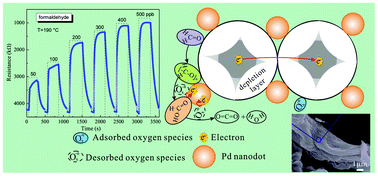A low temperature gas sensor based on Pd-functionalized mesoporous SnO2 fibers for detecting trace formaldehyde
Abstract
The permissible limitation of formaldehyde (HCHO) is 80 ppb in an indoor environment. Hence, the rapid real-time monitoring of trace HCHO is urgent and faced as a great challenge by gas sensors based on semiconducting metal oxides. To enhance the HCHO sensing performance of gas sensors, mesoporous SnO2 fibers are used to fabricate a bare SnO2 sensor and then the sensor is functionalized with Pd nanodots by a facile dipping–annealing process. The obtained Pd-functionalized SnO2 sensor exhibits a very high response to HCHO, ultralow detection limit (50 ppb), excellent sensor selectivity over other reducing gases, and short response and recovery time to 100 ppb HCHO (53 s and 103 s, respectively) at a low working temperature of 190 °C. Herein, the Pd nanodots loaded onto SnO2 fibers serve as sensitizers or promoters, increasing the amount of adsorbates as well as molecule–ion conversion rate and simultaneously providing a new catalytic oxidization pathway of HCHO (HCHO → [CH2O]n (POM) → HCOOH → CO2 + H2O) accompanied with a promotion in the electron transfer rate, and thus improving HCHO sensing performance. The combination of the SnO2 mesoporous structure and catalytic activity of the Pd nanodots loaded could give us a very attractive sensing behavior for applications as real-time monitoring gas sensors with rapid response speed.


 Please wait while we load your content...
Please wait while we load your content...